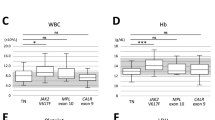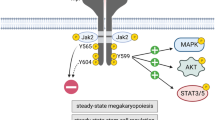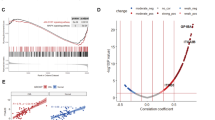Abstract
Essential thrombocythemia (ET) is a chronic myeloproliferative disorder, characterized by increased proliferation of megakaryocytes and elevated platelet count that usually occurs sporadically. We report a family with seven affected individuals in three generations, including one individual with a phenotype resembling polycythemia vera, a related disorder. Megakaryocyte (CFU-MK) colony formation occurred in the absence of added cytokines in cultures of peripheral blood from affected family members. Some reports of familial ET have identified mutations in THPO and MPL, the genes for a cytokine (thrombopoietin, TPO) that regulates platelet production and its receptor (c-MPL), respectively. In this family, the MPL gene was excluded by linkage analysis. Although TPO levels were elevated in most affected family members and evidence for linkage was found between the disease and THPO (θ=0.0, Zmax=3.0), a THPO mutation was not identified by DNA sequencing. The JAK2 V617F mutation that has been associated with 50% of sporadic cases of ET was identified as a somatic mutation, an acquired defect, in peripheral blood of the two most severely affected family members. These patients also had elevated TPO levels. Further study of familial myeloproliferative diseases will help elucidate the initiating genetic events underlying ET.
This is a preview of subscription content, access via your institution
Access options
Subscribe to this journal
Receive 12 print issues and online access
$259.00 per year
only $21.58 per issue
Buy this article
- Purchase on SpringerLink
- Instant access to full article PDF
Prices may be subject to local taxes which are calculated during checkout



Similar content being viewed by others
References
Pearson T . Diagnosis and classification of erythrocytoses and thrombocytoses. Baillieres Clin Haematol 1998; 11: 695–719.
Sterkers Y, Preudhomme C, Lai JL, Demory JL, Caulier MT, Wattel E et al. Acute myeloid leukemia and myelodysplastic syndromes following essential thrombocythemia treated with hydroxyurea: high proportion of cases with 17p deletion. Blood 1998; 91: 616–622.
Shibata K, Shimamoto Y, Suga K, Sano M, Matsuzaki M, Yamaguchi M . Essential thrombocythemia termination in acute leukemia with minimal myeloid differentiation—a brief review of recent literature. Acta Haematol 1994; 91: 84–88.
Murphy S, Peterson P, Iland H, Laszlo J . Expreience of the Polycythemia Vera Study Group with essential thrombocythemia: a final report on diagnostic criteria, survival and leukemic transition by treatment. Semin Hematio 1997; 34: 29–39.
Li T, Hetet G, Maurer AM, Chiat Y, Dhermy D, Briere J . Spontaneous megakaryocyte colony formation in myeloproliferative disorders is not neutralizable by antibodies against IL3, IL6, and GM-CSF. Br J Haematol 1994; 87: 471–476.
Rolovic Z, Basara N, Gotic M, Sefer D, Bogdanovic A . The determination of spontaneous megakaryocyte colony formation is an unequivocal test for discrimination between essential thrombocythemia and reactive thrombocytosis. Br J Haematol 1995; 90: 326–331.
Beutler E, Lichtman M, Coller B, Kipps T, Seligsohn U . Williams Hematology, 6th edn. McGraw-Hill: USA, 2001, pp 689–702; 1541–1550.
Odell Jr TT . Megakaryocytoiesis and its response to stimulation and suppression. In: Baldini MG and Ebbe S (eds). Platelets: Production, Function, Transfusion and Storage. Grunne and Stratton: New York, 1974, pp 11.
Kuter DJ . The regulation of platelet production. In: Kuter DJ, Hunt P, Sheridan W, Zucker-Franklin D (eds). Thrombopoieses and Thrombopoietins: Molecular, Cellular, Preclinical and Clinical Biology. Humana Press: Totowa, NJ, USA, 1997, pp 377–395.
Griesshammer M, Bangerter M, Schrezenmeiter H . A possible role for thrombopoeitin and its receptor c-mpl in the pathobiology of essential thrombocythemia. Semin Thromb Hemost 1997; 23: 419–423.
Souyri M, Vigon I, Penciolelli JF, Heard JM, Tambourin P, Wendling F . A putative truncated cytokine receptor gene transduced by the myeloproliferative leukemia virus immortalizes hematopoietic progenitors. Cell 1990; 63: 1137–1147.
Chang M, Suen Y, Meng G, Buzby JS, Bussel J, Shen V et al. Differential mechanisms in the regulation of endogenous levels of thrombopoietin and interleukin-11 during thrombocytopenia: insight into the regulation of platelet production. Blood 1996; 88: 3354–3362.
Drachman J, Griffin J, Kaushansky K . The c-mpl ligand (TPO) stimulates tyrosine phosphorylation of Jak2, Shc and c-mpl. J Biol Chem 1995; 270: 4979–4982.
Baxter EJ, Scott LM, Campbell PJ, East C, Fourouclas N, Swanton S et al. Acquired mutation of the tyrosine kinase JAK2 in human myeloproliferative disorders. Lancet 2005; 365: 1054–1061.
Kralovics R, Skoda RC . Molecular pathogenesis of Philadelphia chromosome negative myeloproliferative disorders. Blood Rev 2005; 19: 1–13.
Komatsu H, Ding J, Lida M, Ito M, Kato-Uranishi M, Sanda T et al. Familial essential thrombocythemia associated with a dominant positive acting mutation in the c-MPL gene, which encodes for the receptor for thrombopoietin. Blood 2003; 102: 29.
Schlemper R, van der Maas A, Eikenboom J . Familial essential thrombocythemia: clinical characteristics of 11 cases in one family. Ann Hematol 1994; 68: 153–158.
Wiestner A, Schlemper R, van der Maas A, Skoda R . An activating splice donormutation in the thrombopoietin gene causes hereditary thrombocythemia. Nat Genet 1998; 18: 49–52.
Kondo T, Okabe M, Sanada M, Kurosawa M, Suzuki S, Kobayashe M et al. Familial essential thrombocythemia associated with one-base deletion in the 5′-untranslated region of the thrombopoetin gene. Blood 1998; 92: 1091–1096.
Ghilardi N, Wiestner A, M Kikuchi M, Ohsaka A, Skoda R . Hereditary thrombocythemia in a Japanese family is caused by a novel point mutation in the thrombopoetin gene. Br J Hematol 1999; 107: 310–316.
Jaffe ES, Harris NL, Stein H, Vardiman JW . World Health Organization Classification of Tumours, Pathology and Genetics: Tumours of Haematopoietic and Lymphoid Tissues. International Agency for Research on Cancer: Lyon, 2001, pp 15–44.
Gale RE, Mein CA, Linch DC . Quantification of X-chromosome inactivation patterns in haematological samples using the DNA PCR-based HUMARA assay. Leukemia 1996; 10: 362–367.
Renault N, Dyack S, Dobson MJ, Costa T, Lam WL, Greer WL . Heritable skewed X-chromosome inactivation leads to hemophilia A expression in heterozygous females. Eur J Hum Genet 2007; 15: 628–637.
Wiestner A, Padosch SA, Ghilardi N, Cesar JM, Odriozola J, Shapiro A et al. Hereditary thrombocythaemia is a genetically heterogeneous disorder: exclusion of TPO and MPL in two families with hereditary thrombochthaemia. Br J Hematol 2000; 110: 104–109.
Tefferi A, Thiele J, Orazi A, Kvasnicka HM, Barbui T, Hanson CA et al. Proposals and rationale for revision of the World Health Organization diagnostic criteria for Polycythemia Vera, Essential Thrombocythemia and Primary Myelofibrosis: recommendations from an ad hoc international expert panel. Blood 2007; 110: 1092–1097.
Eyster M, Saletan S, Rabellino E, Karanas A, McDonald T, Locke L et al. Familial essential thrombocythemia. Am J Med 1986; 80: 497–502.
Kikuchi M, Tayama T, Hayakawa H, Takahashi I, Hoshino H, Ohsaka A . Familial Thrombocytosis. Br J Hematol 1995; 89: 900–902.
Taskin A, LeCouedic J, Dusanter-Fourt I, Masse A, Giraudier S, Katz A et al. Autonomous megakaryocyte growth in essential thrombocythemia and idiopathic myleofibrosis is not related to a c-mpl mutation or to autocrine stimulation by Mpl-L. Blood 1999; 93: 125–139.
Nucifora G, Rowley JD . AML1 and the 8;21 and 3;21 translocations in acute and chronic myeloid leukemia. Blood 1995; 86: 1–14.
Fialkow J, Faguet G, Jacobson R, Vaidga K, Murphy S . Evidence that ET is a clonal disorder in multipotent stem cells. Blood 1981; 58: 916–919.
Rumi E, Passamonti F, Pietra D, Della Porta MG, Arcaini L, Boggi S et al. JAK2 (V617F) as an acquired somatic mutation and a secondary genetic event associated with disease progression in familial myeloproliferative disorders. Cancer 2006; 107: 2206–2211.
Acknowledgements
This work was supported by the National Organization for Rare Disorders, New Fairfield, Connecticut USA and The Capital District Health Authority, Halifax, Nova Scotia, Canada.
Author information
Authors and Affiliations
Corresponding author
Rights and permissions
About this article
Cite this article
Higgs, J., Sadek, I., Neumann, P. et al. Familial essential thrombocythemia with spontaneous megakaryocyte colony formation and acquired JAK2 mutations. Leukemia 22, 1551–1556 (2008). https://doi.org/10.1038/leu.2008.115
Received:
Revised:
Accepted:
Published:
Issue date:
DOI: https://doi.org/10.1038/leu.2008.115
Keywords
This article is cited by
-
Back to Biology: New Insights on Inheritance in Myeloproliferative Disorders
Current Hematologic Malignancy Reports (2014)



